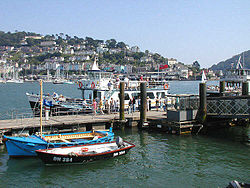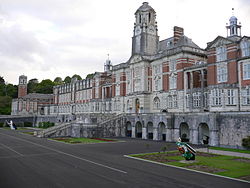Dartmouth
| Dartmouth | |
| Devon | |
|---|---|
 Dartmouth from the river | |
| Location | |
| Grid reference: | SX877514 |
| Location: | 50°21’4"N, 3°34’44"W |
| Data | |
| Population: | 5,512 (2001) |
| Post town: | Dartmouth |
| Postcode: | TQ6 |
| Dialling code: | 01803 |
| Local Government | |
| Council: | South Hams |
| Parliamentary constituency: |
Totnes |
Dartmouth is a busy port and naval town in Devon. It stands on the south bank of the estuary of the River Dart, which opens into the English Channel just below the town. The estuary is a broad water between hill slopes which provides a good and capacious sheltered harbour and which is tidal and navigable as far up as Totnes.
All officers of the Royal Navy have been through Dartmouth, trained at the Britannia Naval College on the hill overlooking the town and on training ships on the Dart and on the sea. Dartmouth and Kingswear on the opposite bank are busy with fishing boats and yachts. The town's shops, chandleries, hostelries and institutions show a singular devotion to the sea.
Dartmouth is within the South Devon Area of Outstanding Natural Beauty. It had a population of 5,512 at the 2001 Census.
History and historic structure
The history if Dartmouth is told in its buildings, from the castle on the headland to the ancient houses of the town.
Middle Ages
Dartmouth has long been of strategic importance as a deep-water port for sailing vessels. The port was used as the sailing point for the Crusades of 1147 and 1190, and a creek close to Dartmouth Castle is supposed by some to be named for the vast fleets which assembled there (Warfleet Creek). It was a home of the Royal Navy from the reign of Edward III and was twice surprised and sacked during the Hundred Years' War, after which the mouth of the estuary was closed every night with a great chain. The narrow mouth of the Dart is protected by two fortified castles, Dartmouth Castle and Kingswear Castle. Originally Dartmouth's only wharf was Bayard's Cove, a relatively small but picturesque area protected by a fort at the southern end of the town.
In 1373 Geoffrey Chaucer visited and among the pilgrims in his Canterbury Tales
A schipman was ther, wonyng fer by weste;
For ought I wost, he was of Dertemouthe.
Dartmouth was also a major base for privateering in the Middle Ages. John Hawley or Hauley,[1] a licensed privateer and sometime mayor of Dartmouth [2] is reputed to be a model for Chaucer's "schipman".
One of the most attractive old streets is Smith Street and is the earliest street in Dartmouth to be recorded by name (in the 13th century). Several of the houses on the street are originally late 16th century or early 17th century and likely rebuilt on the site of earlier mediæval dwellings. The street name undoubtedly derives from the smiths and shipwrights who built and repaired ships here when the tidal waters reached as far as this point. Smith Street was also the site of the town pillory in mediæval times.

St Saviour's church was built in 1335 and consecrated in 1372. It contains a splendid pre-reformation oak rood screen built in 1480 and several other handsome monuments including the tomb of John Hawley (d. 1408) and his two wives, covered with a large brass plate effigy of all three. A large mediæval ironwork door is decorated with two leopards of the Plantagenets and is possibly the original portal. Although it is dated "1631", this is thought to be the date of a subsequent refurbishment coincidental with major renovations of the church in the 17th century.[3] The gallery of the church is decorated with the heraldic crests of prominent local families and is reputed to be constructed of timbers from ships captured during the defeat of the Spanish Armada, although this has not been categorically substantiated.
Early Modern Period
In 1592 the Madre de Deus, a Portuguese treasure ship captured by the English, docked at Dartmouth Harbour, towering over the other ships and the town's small houses. Nothing like it had ever been seen in England and pandemonium broke loose. Madre de Deus attracted all manner of traders, dealers, cutpurses and thieves. By the time Sir Walter Raleigh arrived to reclaim the Crown's share of the loot, a cargo estimated at half a million pounds had been reduced to £140,000, but still ten freighters were needed to carry the treasure around the coast and up the River Thames to London.
Henry Hudson put in to Dartmouth on his return from America, and was arrested for sailing under a foreign flag. The Pilgrim Fathers put in to Dartmouth's Bayard's Cove, en route from Southampton to America. They rested a while before setting off on their journey in the Mayflower and the Speedwell on 20 August 1620. About 300 miles west of Land's End, upon realising that the Speedwell was unseaworthy, it returned to Plymouth. The Mayflower departed alone to complete the crossing to Cape Cod. They did found a town named Dartmouth, now in the state of Massachusetts.

The town contains many mediæval and Elizabethan streetscapes and is a patchwork of narrow lanes and stone stairways. A significant number of the historic buildings are listed.[4] One of the most obvious is the Butterwalk, built 1635 to 1640. Its intricately carved wooden fascia is supported on granite columns.
Charles II held court in the Butterwalk whilst sheltering from storms in 1671 in a room which now forms part of Dartmouth Museum.[5] Much of the interior survives from that time.
The Royal Castle Hotel was built in 1639 on the then new quay. The building was refronted in the 19th century, and as the new frontage is itself listed, it is not possible to see the original which lies beneath. A claimant for the oldest building is a former merchant's house in Higher Street, now a public house called The Cherub, built circa 1380. Agincourt House (next to the Lower Ferry) is also 14th century.
Dartmouth sent numerous ships to join the English fleet that attacked the Armada, including the Roebuck, Crescent and Hart.[6] The Neustra Señora del Rosario, the Spanish Armada's "payship" commanded by Admiral Pedro de Valdés, was captured along with all its crew by Sir Francis Drake. It was reportedly anchored in the river Dart for more than a year and the crew were used as labourers on the nearby Greenway Estate which was the home of Sir Humphrey Gilbert and his half-brother Sir Walter Raleigh. Greenway was subsequently the home of Dame Agatha Christie.[7]
The remains of a fort at Gallants Bower just outside the town are some of the best preserved remains of a Civil War defensive structure. The fort was built by Royalist occupation forces in c. 1643 to the south east of the town, with a similar fort at Mount Ridley on the opposite slopes of what is now Kingswear. The Parliamentarian General Fairfax attacked from the north in 1646, taking the town and forcing the Royalists to surrender, after which Gallants Bower was demolished.
Nineteenth century
The made-up embankment which today extends the whole length of the town's riverbank is the result of 19th century land reclamation, started in earnest when the town played host to a large number of prisoners of war from the Napoleonic Wars which formed a captive workforce. Before this, what is now the town centre was almost entirely tidal mud flats.
The Royal National Lifeboat Institution opened a lifeboat station at the Sand Quay in 1878, but it was closed in 1896. In all this time only one effective rescue was made by the lifeboat.[8]
Twentieth century

In the latter part of Second World War the town was a base for American forces and one of the departure points for Utah Beach in the Normandy Landings. Much of the surrounding countryside was closed to the public while it was used by US troops for practise landings and manoeuvres.
In 2010, a fire seriously damaged numerous historical properties in Fairfax Place and Higher Street. Several were Tudor and Grade I or Grade II listed buildings.[9]
Culture
The Port of Dartmouth Royal Regatta takes place annually over three days at the end of August.
Bayard's Cove has been used in several television productions, including The Onedin Line[10] a popular BBC television drama series that ran from 1971 to 1980.
Ferries

Dartmouth is linked to Kingswear, on the other side of the River Dart, by three ferries. The Higher Ferry and the Lower Ferry are both vehicular ferries. The Passenger Ferry, as its name suggests, carries only passengers, principally to connect with the Paignton and Dartmouth Steam Railway at Kingswear station.
A small passenger ferry runs too between Dartmouth Castle and the town.
Royal Naval College

The Britannia Royal Naval College stands in a commanding position on a hill overlooking the town and river. It is the Royal Navy's officer training college, where all officers of the Royal Navy and many Commonwealth and foreign naval officers are trained. Training has taken place in the town since 1863, but the buildings which are seen today were only finished in 1905. Since 1998, the Britannia Royal Naval Colleg has been the sole centre for Royal Naval officer training.
Before the college was built, cadets lived in two ships moored in the River Dart; the Britannia and the Hindustan. The original ships have long since been decommissioned, but college took the name of one, becoming (in the naval manner) HMS Britannia, and the training ship on the Dart is named the Hindostan (which was formerly the Sandown class minehunter HMS Cromer).
The college dropped the ship name Britannia in 1953 when the new Royal Yacht was given than name, and became HMS Dartmouth, but unwilling to lose the name entirely its full name became the Britannia Royal Naval College.
Sport and leisure
- Football: Dartmouth AFC
Outside links
| ("Wikimedia Commons" has material about Dartmouth) |
References
- ↑ "John Hawley of Dartmouth". Devonperspectives.co.uk. 2012-02-11. http://www.devonperspectives.co.uk/johnhawley.html. Retrieved 2012-10-25.
- ↑ "Roll Of Mayoralty". Dartmouth-history.org.uk. http://www.dartmouth-history.org.uk/content_images/upload/Town_Mayors.htm. Retrieved 2012-10-25.
- ↑ "St Saviour, Dartmouth, Devon - Church". Roughwood.net. 2009-02-27. http://www.roughwood.net/ChurchAlbum/Devon/Dartmouth/Dartmouth-St-Saviour.htm. Retrieved 2012-10-25.
- ↑ {Listed Buildings in Dartmouth – British Listed Buildings]
- ↑ "The King's Room at Dartmouth Museum". Dartmouth Museum. http://dartmouthmuseum.org/collections/kings-room/index.html. Retrieved 29 July 2011. "It was in this magnificent room that King Charles II was entertained in July 1671, when storms forced him to seek shelter in Dartmouth."
- ↑ http://www.dartmouth-history.org.uk/content_images/upload/Russells_Dartmouth.pdf
- ↑ "Dartmouth, Devon - Destinations UK". Historic-uk.com. 1944-06-04. http://www.historic-uk.com/DestinationsUK/Dartmouth.htm. Retrieved 2012-10-25.
- ↑ Leach, Nicholas (2009). Devon's Lifeboat Heritage. Chacewater: Twelveheads Press. pp. 19–20. ISBN 978-0-906294-72-7.
- ↑ "Dartmouth's Tudor buildings destroyed by chip shop fire". BBC News. 29 May 2010. http://news.bbc.co.uk/2/hi/england/devon/10189310.stm. Retrieved 30 May 2010.
- ↑ "Things to Do". Dartmouth Museum. http://dartmouthmuseum.org/things-to-do/#bayardscove. Retrieved 19 August 2011. "Bayards Cove was used in the BBC period drama The Onedin Line to represent the wharves and buildings of Liverpool Docks."